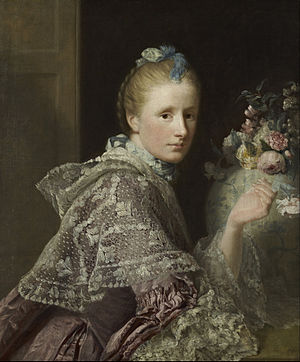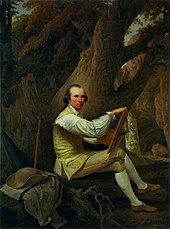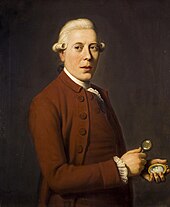Scottish art in the eighteenth century

Scottish art in the eighteenth century is the body of
The origins of the tradition of Scottish landscape painting are in the
Neoclassicism was pioneered by
Background
Professionalisation
Many Scottish painters of the early part of the eighteenth century remained largely artisans. Roderick Chalmers' (fl. 1709–30) painting The Edinburgh Trades (1720) shows the artist himself, perhaps ironically, among the glaziers, wrights and masons of the burgh.[1] Thomas Warrender (fl. 1673–1713) produced the Allegorical Still Life (after 1708), of a letter board that seems to be a commentary on the union of 1707, but he made his living as a house decorator, working closely with architects, including William Adam.[2] He may have trained James Norie (1684–1757), who with his sons James (1711–36) and Robert (d. 1766), painted the houses of the peerage with Scottish landscapes that were pastiches of Italian and Dutch landscapes.[3] They tutored many artists and have been credited with the inception of the tradition of Scottish landscape painting that would come to fruition from the late eighteenth century.[4] The painters Allan Ramsay (1713–84), Gavin Hamilton (1723–98), the brothers John (1744–68/9) and Alexander Runciman (1736–85), Jacob More (1740–93) and David Allan (1744–96), mostly began in the tradition of the Nories, but were artists of European significance, spending considerable portions of their careers outside Scotland.[5] Henry Raeburn (1756–1823) was the most significant artist of the period to pursue his entire career in Scotland, born in Edinburgh and returning there after a trip to Italy in 1786.[6]
In 1729 the first academy of art in Scotland was established in Edinburgh as the Academy of St. Luke, inspired by the Guilds of St. Luke across Europe and particularly the
The growing importance of art can be seen in the post of Royal Painter and Limner, created in 1702 for George Ogilvie. The duties included "drawing pictures of our [Monarch's] person or of our successors or others of our royal family for the decorment of our houses and palaces". However, from 1723 to 1823 the office was a sinecure held by members of the Abercrombie family, not necessarily connected with artistic ability.[10]
Intellectual trends

All the major painters of the period were to varying degrees influenced by forms of Neoclassicism, which revived Greek and Roman form of artistic expression.[5] Italy became an important point of reference for Scottish artists, with over fifty artists and architects known to have travelled there in the period 1730–80 as part of a Grand Tour, to paint, sample the art and learn from Italian masters.[5] With so many artists visiting or resident, Rome became almost a "Third Academy)" for Scots.[11] In the second half of the century Scots became the major figures in the trade in antique sculpture, particularly Gavin Hamilton, Colin Morison (1732–1801) and James Byres (1734–1817), making them the arbiters of British taste in this area. However, the only major Scottish collection of marble before the nineteenth century was that of James Johnstone, 2nd Marquess of Annandale.[12]
Scottish artists in the later eighteenth century were strongly influenced by the
Forms
Landscape

The origins of the Scottish landscape painting tradition are in the Nories' capriccios or pastiches of Italian and Dutch landscapes.[3] Jacob More, having trained with the Nories, moved to Italy in 1773 and is chiefly known as a landscape painter.[3] This period saw a shift in attitudes to the Highlands and mountain landscapes in general, from viewing them as hostile, empty regions occupied by backwards and marginal people, to interpreting them as aesthetically pleasing exemplars of nature, occupied by rugged primitives, which were now depicted in a dramatic fashion.[14] Produced before his departure to Italy, More's series of four "Falls of Clyde" (1771–73) paintings have been described by art historian Duncan Macmillan as treating the waterfalls as "a kind of natural national monument" and has been seen as an early work in developing a romantic sensibility to the Scottish landscape.[14]
Alexander Nasmyth visited Italy and worked in London, but returned to his native Edinburgh for most of his career. He produced work in a large range of forms, including his portrait of Romantic poet
Portraiture

Aberdeen-born John Alexander and William Mossman were the leading portrait artists of the first half of the century. John Alexander was born in Aberdeen and was a great grandson of portrait painter
Allan Ramsay studied in Sweden, London and Italy before basing himself in Edinburgh, where he established himself as a leading portrait painter to the Scottish nobility and he undertook portraits of many of the major figures of the Scottish Enlightenment, including his friend the philosopher
The leading portrait painter of the second half of the century was
Neoclassism and genre painting

Gavin Hamilton spent almost his entire career in Italy and emerged as a pioneering neoclassical painter of historical and mythical themes, including his depictions of scenes from Homer's Iliad, as well as having been an informal tutor to British artists, early archaeologist and antiquarian.[23] Many of his works can be seen as Enlightenment speculations about the origins of society and politics, including the Death of Lucretia (1768), an event thought to be critical to the birth of the Roman Republic. His classicism would be a major influence on French artist Jacques-Louis David (1748–1825).[24]
John and Alexander Runciman both gained reputations as painters of mythological and historical themes. They travelled to Italy, where they worked with Hamilton. John died in 1768/9 and Alexander returned home. His most widely known work, distributed in etchings, was mythological.[25] His version of The Origin of Painting (1773), depicting Pliny's story of a young Corinthian woman outlining a shadow on the wall, has her hand guided by Cupid, suggesting the ultimate motivation for art was love. The same theme was painted by another of Hamilton's protégés, David Allan, two years later.[26] In the late eighteenth century Ossian became a common subject for Scottish artists, and works were undertaken by Alexander Runciman and David Allan among others.[25][27]
Alexander also produced one of the earliest examples of a Scottish historical painting, showing the escape of
Sculpture

After the
As in England, commissions of new statuary tended to be made in relatively cheap lead and even more economical painted or gilded plaster. The plasterwork of
From the late eighteenth century there are a handful of examples of work from Scottish artists. These included statues of druids on the
References
Notes
- ^ a b MacDonald, Scottish Art, p. 56.
- ^ MacDonald, Scottish Art, p. 51.
- ^ a b c Baudino, "Aesthetics and Mapping the British Identity in Painting", p. 153.
- ^ Waterhouse, Painting in Britain: 1530 to 1790, p. 293.
- ^ a b c Wormald, Scotland: A History.
- ^ a b c Campbell, Edinburgh: A Cultural and Literary History, pp. 142–3.
- ^ Smart, The Life and Art of Allan Ramsay, p. 11.
- ^ Brydall, Robert, Art in Scotland: Its Origin and Progress (Edinburgh 1889) pp. 110-11. He transcribed the Charter for the establishment of the Academy where items IV and V refer specifically to the life class. Mackie, Lenman and Parker, A History of Scotland, p. 311.
- ^ a b MacDonald, Scottish Art, p. 57.
- ^ The Laws of Scotland: Stair Memorial Encyclopaedia, vol. 7 "The Crown", para 847.
- ^ MacDonald, Scottish Art, p. 64.
- ^ Skinner, "Scottish Connoisseurship and the Grand Tour", pp. 39–40.
- ^ Buchan, Crowded with Genius, p. 163.
- ^ ISBN 0-521-64202-7, pp. 151–3.
- ^ Chilvers, The Oxford Dictionary of Art and Artists, p. 433.
- ^ MacDonald, Scottish Art, pp. 78–83.
- ^ Hill, Picturing Scotland Through the Waverley Novels, p. 104.
- ^ Kemp, The Pleasures and Treasures of Britain, p. 401.
- ^ Waterhouse, Painting in Britain, p. 293.
- ^ Waterhouse, Painting in Britain, p. 330.
- ^ "Allan Ramsey", Encyclopædia Britannica, retrieved 7 May 2012.
- ^ Ochterbeck, Michelin Green Guide: Great Britain Edition, p. 84.
- ^ "Gavin Hamilton", Encyclopædia Britannica, retrieved 7 May 2012.
- ^ MacDonald, Scottish Art, pp. 63–5.
- ^ a b Chilvers, The Oxford Dictionary of Art and Artists, p. 554.
- ^ a b MacDonald, Scottish Art, p. 65.
- ^ a b The Houghton Mifflin Dictionary of Biography, pp. 34–5.
- ^ MacDonald, Scottish Art, pp. 56, 64.
- ^ MacDonald, Scottish Art, pp. 84–7.
- ^ Clifford, "Introduction", p. 9.
- ^ Baker, "Proper ornaments for a library or Grotto", p. 47.
- ^ Clifford, "Introduction", pp. 14–15.
- ^ Clifford, "Introduction", pp. 13–14.
- ^ Clifford, "Introduction", p. 16.
Bibliography
- Baker, M., "'Proper ornaments for a library or Grotto': London sculptors and their Scottish patrons in the eighteenth century" in Fiona Pearson, ed., Virtue and Vision: Sculpture in Scotland 1540–1990 (Edinburgh: ISBN 0-903598-14-0.
- Baudino, I., "Aesthetics and Mapping the British Identity in Painting", in Anja Müller and Isabel Karremann, ed., Mediating Identities in Eighteenth-Century England: Public Negotiations, Literary Discourses, Topography (Burlington, VT; Aldershot: Ashgate, 2011), ISBN 1-4094-2618-1.
- Buchan, James, Crowded with Genius (New York; London: ISBN 0-06-055888-1.
- Campbell, Donald, Edinburgh: A Cultural and Literary History (Oxford: Signal Books, 2003), ISBN 1-902669-73-8.
- Chilvers, Ian, ed., The Oxford Dictionary of Art and Artists (Oxford: ISBN 0-19-953294-X.
- Clifford, T., "Introduction", in Fiona Pearson, ed., Virtue and Vision: Sculpture in Scotland 1540–1990 (Edinburgh: National Galleries of Scotland, 1991), ISBN 0-903598-14-0.
- Hill, Richard J., Picturing Scotland Through the Waverley Novels: Walter Scott and the Origins of the Victorian Illustrated Novel (Burlington, VT; Farnham, Surry; Aldershot: Ashgate, 2010), ISBN 0-7546-6806-1, p. 104.
- Kemp, David, The Pleasures and Treasures of Britain: A Discerning Traveller's Companion (Toronto: Dundurn, 1992), ISBN 1-55002-159-1.
- MacDonald, Murdo, Scottish Art (New York; London: Thames and Hudson, 2000), ISBN 0-500-20333-4.
- Mackie, J. D., Lenman, B. and Parker, G., A History of Scotland (London: ISBN 0-14-013649-5.
- Ochterbeck, C. C., ed., Michelin Green Guide: Great Britain Edition (Greenville, South Carolina; London: ISBN 1-906261-08-3.
- Skinner, B., "Scottish Connoisseurship and the Grand Tour" in Fiona Pearson, ed., Virtue and Vision: Sculpture in Scotland 1540–1990 (Edinburgh: National Galleries of Scotland, 1991), ISBN 0-903598-14-0.
- Smart, A., The Life and Art of Allan Ramsay (London: Taylor & Francis, 1951).
- The Houghton Mifflin Dictionary of Biography (Boston, MA: ISBN 0-618-25210-X.
- Waterhouse, Ellis K., Painting in Britain: 1530 to 1790 (New Haven, CT: ISBN 0-300-05833-0.
- Withers, Charles W. J., Geography, Science and National Identity: Scotland Since 1520 (Cambridge: ISBN 0-521-64202-7.
- Wormald, J., Scotland: A History (Oxford: Oxford University Press, 2005), ISBN 0-19-162243-5.
